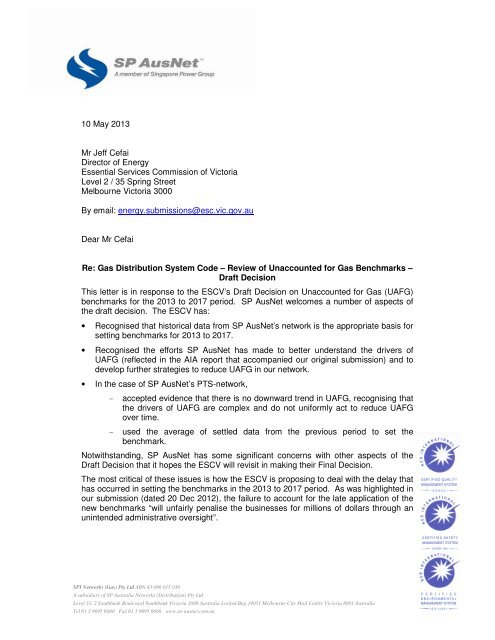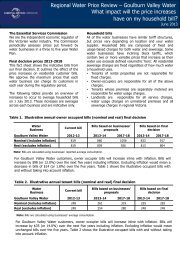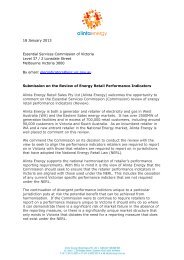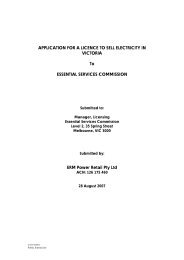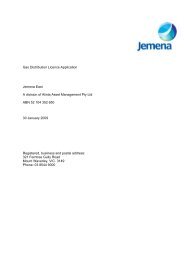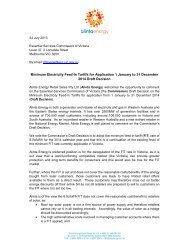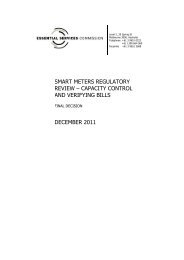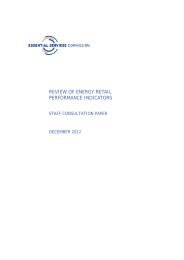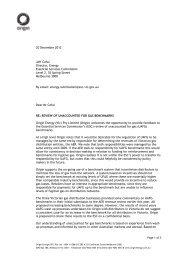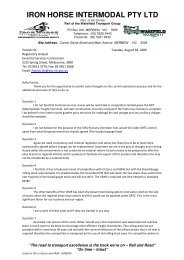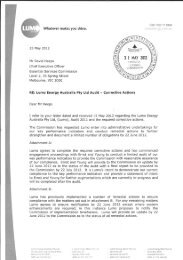SP Ausnet - Essential Services Commission
SP Ausnet - Essential Services Commission
SP Ausnet - Essential Services Commission
Create successful ePaper yourself
Turn your PDF publications into a flip-book with our unique Google optimized e-Paper software.
10 May 2013<br />
Mr Jeff Cefai<br />
Director of Energy<br />
<strong>Essential</strong> <strong>Services</strong> <strong>Commission</strong> of Victoria<br />
Level 2 / 35 Spring Street<br />
Melbourne Victoria 3000<br />
By email: energy.submissions@esc.vic.gov.au<br />
Dear Mr Cefai<br />
Re: Gas Distribution System Code – Review of Unaccounted for Gas Benchmarks –<br />
Draft Decision<br />
This letter is in response to the ESCV’s Draft Decision on Unaccounted for Gas (UAFG)<br />
benchmarks for the 2013 to 2017 period. <strong>SP</strong> AusNet welcomes a number of aspects of<br />
the draft decision. The ESCV has:<br />
• Recognised that historical data from <strong>SP</strong> AusNet’s network is the appropriate basis for<br />
setting benchmarks for 2013 to 2017.<br />
• Recognised the efforts <strong>SP</strong> AusNet has made to better understand the drivers of<br />
UAFG (reflected in the AIA report that accompanied our original submission) and to<br />
develop further strategies to reduce UAFG in our network.<br />
• In the case of <strong>SP</strong> AusNet’s PTS-network,<br />
- accepted evidence that there is no downward trend in UAFG, recognising that<br />
the drivers of UAFG are complex and do not uniformly act to reduce UAFG<br />
over time.<br />
- used the average of settled data from the previous period to set the<br />
benchmark.<br />
Notwithstanding, <strong>SP</strong> AusNet has some significant concerns with other aspects of the<br />
Draft Decision that it hopes the ESCV will revisit in making their Final Decision.<br />
The most critical of these issues is how the ESCV is proposing to deal with the delay that<br />
has occurred in setting the benchmarks in the 2013 to 2017 period. As was highlighted in<br />
our submission (dated 20 Dec 2012), the failure to account for the late application of the<br />
new benchmarks “will unfairly penalise the businesses for millions of dollars through an<br />
unintended administrative oversight”.<br />
<strong>SP</strong>I Networks (Gas) Pty Ltd ABN 43 086 015 036<br />
A subsidiary of <strong>SP</strong> Australia Networks (Distribution) Pty Ltd<br />
Level 31, 2 Southbank Boulevard Southbank Victoria 3006 Australia Locked Bag 14051 Melbourne City Mail Centre Victoria 8001 Australia<br />
Tel 61 3 9695 6000 Fax 61 3 9695 6666 www.sp-ausnet.com.au
In the attached response to the Draft Decision, we set out in further detail the unfair<br />
consequences of the current approach and demonstrate adjustments that could and<br />
should be made to rectify the error.<br />
<strong>SP</strong> AusNet also has concerns with the trend analysis applied to the benchmarks for its’<br />
non-PTS network. Consistent with our original submission, <strong>SP</strong> AusNet does not believe<br />
the evidence supports setting a benchmark with a significant declining trend.<br />
Should you have any questions in relation to this matter please contact Katie Yates,<br />
Principle Economist, Asset Management on 9695-6622.<br />
Yours sincerely,<br />
Tom Hallam<br />
Manager Economic Regulation<br />
Asset Management<br />
<strong>SP</strong> AusNet<br />
Page 2
<strong>SP</strong> AusNet – Response to Draft Decision<br />
2013 Benchmarks<br />
In its Draft Decision the ESCV proposes that the new benchmark for 2013 would<br />
commence from 1 July 2013. The ESCV pointed to administrative issues that would<br />
hinder retrospective adjustment to the benchmarks that had been requested by<br />
<strong>SP</strong> AusNet.<br />
“The <strong>Commission</strong> does not consider it appropriate to make the<br />
benchmarks retrospective as the Order sets the benchmarks until the<br />
Order is repealed. In addition, the <strong>Commission</strong> notes there are practical<br />
issues for AEMO—who use the benchmarks prospectively for wholesale<br />
market settlement purposes—in making the benchmarks retrospective.<br />
There are also administrative issues for the <strong>Commission</strong> to consider in<br />
making the benchmarks retrospective. Specifically schedule 4 of the<br />
GDSC, which provides for the <strong>Commission</strong> to amend the GDSC, states<br />
that:<br />
the date specified on the amendment must not be earlier than the date<br />
on which the amendment is made without the prior agreement from<br />
Distributors and the <strong>Commission</strong>'s Customer Consultative Committee.” 1<br />
As outlined in <strong>SP</strong> AusNet’s original submission, the delay that has occurred in<br />
updating UAFG benchmarks has resulted in a penalty to <strong>SP</strong> AusNet and is<br />
inconsistent with the design of the scheme. This is because the effective benchmark<br />
that applies for the 2013 calendar year is different to the benchmark that has been<br />
deemed appropriate by the ESCV. Therefore, the updated benchmark for the<br />
second half of 2013 must be adjusted to correct this penalty.<br />
Delay to benchmark adjustment<br />
The UAFG benchmarks are intended to be updated every 5 years (in line with<br />
regulatory periods). This ensures that the benchmarks reflect current network<br />
conditions.<br />
Victorian Gas Distribution Businesses (GDBs) are funded on the basis that they are<br />
expected to achieve the benchmark result on average (because the benchmark is<br />
based on historical results, with the incentive scheme working by rewarding<br />
improvements over time and penalising deteriorations). The recent GAAR Final<br />
Decision set prices on this basis.<br />
The delay to the setting of the benchmarks has been due in no part to the actions of<br />
Victorian distribution businesses. <strong>SP</strong> AusNet submitted material as part of the<br />
Victorian Gas Access Arrangement Review with plenty of time for the new<br />
benchmarks to be set.<br />
<strong>SP</strong> AusNet understands that the causes of the delay were bureaucratic, possibly due<br />
to the delay in implementing the National Energy Customer Framework in Victoria,<br />
and involving disputes between state and Commonwealth government agencies,<br />
including the AER, AEMO and the ESC (and potentially others), over whose<br />
responsibility it was to update the benchmarks. Whatever the detailed causes of the<br />
1 ESCV, March 2013, Gas Distribution System Code – Review of Unaccounted for Gas Benchmarks –<br />
Draft Decision, p.5<br />
Page 3
ureaucratic delay, the result was the requirement for a Ministerial Order to extend<br />
the existing benchmarks that were due to expire at the end of 2012.<br />
Based on the proposed benchmarks in the draft decision, the delayed start to<br />
updating the benchmarks will result in a windfall loss to <strong>SP</strong> AusNet.<br />
Penalty to <strong>SP</strong> AusNet<br />
To demonstrate the effect of the delay, <strong>SP</strong> AusNet has modelled the outcome that<br />
will result from the Draft Decision if we achieve the 2013 benchmark (that is, what<br />
happens if <strong>SP</strong> AusNet’s UAFG in 2013 is equal the benchmark level of 5.4% that<br />
ESCV determined to be the expected outcome based on historical results).<br />
Figure 1 maps the relationship between <strong>SP</strong> AusNet’s actual UAFG for 2013 and the<br />
penalty or reward it will incur under various UAFG benchmarks.<br />
Under the Draft Decision, a 4.9% benchmark will apply for the first 6 months of 2013<br />
(as stipulated in the special gazette s460). This is shown by the red line. After 1 July<br />
an updated UAFG benchmark of 5.4% for the remaining 6 months of 2013, as shown<br />
in the blue line. The green line reflects the effective benchmark of 5.15% applied for<br />
Type B customers (for <strong>SP</strong> AusNet) for 2013 under the draft decision.<br />
Figure 1.<br />
Figure 1 shows that regardless of the actual result, <strong>SP</strong> AusNet will pay more in<br />
penalty (or receive less in reward) in 2013 than if the benchmark had been updated<br />
at the start of the year – to the tune of half a million dollars.<br />
The blue line represents the UAFG benchmark of 5.4% applied to <strong>SP</strong> AusNet’s<br />
network for Type B connections in 2013 (i.e. the ESC Draft Decision). Under the<br />
expected scenario where actual UAFG and Benchmark UAFG are equal, there is no<br />
financial reconciliation required. (Point A)<br />
As the UAFG benchmark will increase under the ESCV Draft Decision, the delay in<br />
setting the benchmark has the impact of decreasing the effective benchmark for the<br />
period. The effective benchmark (i.e. the weighted average of 5.4% and 4.9% -<br />
based on time) is 5.15% for 2013. As UAFG is expected to be 5.4%, the effective<br />
reduction in UAFG benchmark increases <strong>SP</strong> AusNet’s financial liability. Using 2010<br />
Page 4
flow data as an estimate for 2013 flow data, this increased liability is in excess of<br />
$450k (Point B). 2 A delay in updating the GDSC the last time the benchmarks were<br />
adjusted resulted in a ‘delay penalty’ to <strong>SP</strong> AusNet of over $1 million in 2008 when<br />
the old benchmark of 4.5% was applied instead of the approved benchmark of 5.1%.<br />
The delay to the benchmark adjustment results in a loss to <strong>SP</strong> AusNet and a windfall<br />
gain to retailers. However, if the benchmark was falling the situation would be<br />
reversed. Neither situation is desirable.<br />
<strong>SP</strong> AusNet does not believe there is any basis for the penalty it faces under the Draft<br />
Decision proposal and believes that ESCV should adjust the 2013 benchmark<br />
appropriately to achieve a fair result.<br />
Addressing problems from delay to updating benchmarks<br />
<strong>SP</strong> AusNet accepts that a mechanism for retrospective adjustments to benchmarks<br />
may not exist. However, the administrative hurdles identified by the ESCV do not<br />
negate the need to ensure a fair outcome for the 2013 calendar year. ESCV could<br />
redress the penalty that has been imposed on the <strong>SP</strong> AusNet from the delay by<br />
making appropriate adjustments to the benchmark that will apply from 1 July 2013.<br />
ESCV identified three concerns with respect to setting a ‘blended target’ (a target<br />
adjusted to reflect the wrong benchmark being used for the first six months) for 2013:<br />
1. They do not have the data to set an accurate blended benchmark;<br />
2. Seasonal factors may affect UAFG; and<br />
3. A blended figure would exacerbate the uncertainty in UAFG over the full calendar<br />
year.<br />
These concerns can be substantially addressed and do not justify the blunt ‘do<br />
nothing’ approach of the draft decision.<br />
It is true that it is not possible to prospectively know all of the information required to<br />
perfectly set a blended UAFG benchmark. For example, total annual gas volumes<br />
and flow will affect the annual UAFG outcome. Similarly, seasonal factors will affect<br />
at what time of year most gas is consumed. However, this information can be<br />
forecast reasonably accurately. A blended benchmark based on such forecast<br />
information would be far more accurate that using a benchmark that assumes no<br />
error from the first six months.<br />
The difficulty faced with setting a blended 2013 benchmark is similar to that faced by<br />
the AER in setting tariffs for 2013 in its recent Victorian Gas Access Arrangement<br />
Review, where the start of new tariffs was also delayed by six months. The AER was<br />
able to address this by using historical weather and consumption data to set simple<br />
assumptions about gas demand for 2013, to ensure that over the year the revenue<br />
collected from customers was in line with that approved in their Final Determination.<br />
Below, <strong>SP</strong> AusNet provides two possible mechanisms that could be used to set a<br />
blended target for 2013. Both would substantially reduce the error over the 2013<br />
year relative to the Draft Decision.<br />
In relation to the third of the ESCV’s concerns, <strong>SP</strong> AusNet does not believe that<br />
setting a blended target would result in uncertainty with respect to any material<br />
issues associated with UAFG. Firstly, the incentive rate will be the same throughout<br />
2013 regardless of the benchmark that is set, so there will be no effect on actual<br />
UAFG volumes. Secondly, given there will be a new benchmark from July 1, it is not<br />
2<br />
The actual penalty is affected by the volume and flow of gas in 2013. The model uses 2010 data<br />
to model flow through 2013. <strong>SP</strong> AusNet can provide further details if required.<br />
Page 5
clear what additional uncertainty setting the benchmark at the blended rate would<br />
cause.<br />
Mechanisms for calculating a ‘blended benchmark’<br />
To provide equity, due to the delay in publishing the revised UAFG benchmarks, an<br />
adjustment is made to the part year 2013 (i.e. Jul to Dec) benchmark so that the<br />
weighted average benchmark for the full calendar year remains consistent with the<br />
ESCV Final Decision on UAFG benchmarks (i.e. 5.4% within the Draft Decision).<br />
The simplest approach to setting a blended benchmark is an adjustment based on<br />
the number of days each benchmark would apply. The following formulae shows the<br />
calculation of the pro-rata benchmark based of the full calendar year benchmark<br />
provided for in the Final Decision.<br />
B CY = Full Calendar Year Class B Benchmark as per ESC - Final Decision<br />
B 1 = Interim 2013 <strong>SP</strong> AusNet Class B Benchmark (Victoria Government Gazette No. S 460)<br />
B 2 = Adjusted 2013 <strong>SP</strong> AusNet Class B Benchmark<br />
D 1 = Period in days that the Benchmarks provided for in Gazette S 460 was applied over.<br />
The following example provides a final adjusted benchmark that would be declared in<br />
the amended Schedule 1, Part C Unaccounted For Gas of the GDSC for the period<br />
remaining in the 2013 calendar year post the final decision on UAFG benchmarks.<br />
B CY = 5.4% as per the ESC Draft Decision – <strong>SP</strong> AusNet 2013 Class B Benchmark<br />
B 1 = 4.9% as per the Victoria Government Gazette No. S 460 - <strong>SP</strong> AusNet 2013 Class B<br />
Benchmark<br />
B 2 = Final adjusted 2013 <strong>SP</strong> AusNet Class B Benchmark<br />
D 1 = 181 days based on the period from 1 January 2013 to 30 June 2013 (proposed GDSC<br />
amended effective 1 July 2013).<br />
A slightly more sophisticated approach to setting the blended benchmark would be to<br />
base it on historical gas consumption patterns. The formula shows how this could<br />
work using data from a nominated ‘benchmark year’, although this could also be<br />
done using historical averages.<br />
Page 6
B CY = Full Calendar Year Class B Benchmark as per ESC - Final Decision,<br />
B 1 = Interim 2013 <strong>SP</strong> AusNet Class B Benchmark (Victoria Government Gazette No. S 460)<br />
F 1 = Total Type B consumption in corresponding period of benchmark year (as per Victoria<br />
Government Gazette No. S 460),<br />
B 2 = Adjusted 2013 <strong>SP</strong> AusNet Class B Benchmark, and<br />
F Bench = Total Type B consumption in the selected benchmark year.<br />
The following example provides a final adjusted benchmark that would be declared in<br />
the amended Schedule 1, Part C Unaccounted For Gas of the GDSC for the period<br />
remaining in the 2013 calendar year post the final decision on UAFG benchmarks.<br />
Calendar year 2010 has been used for the benchmark year due to the similarity of<br />
outcomes that year to the benchmark from the ESCV draft decision. The Final<br />
Decision is assumed to be introduced on 1 July 2013.<br />
B CY = 5.4% as per the ESC Draft Decision – <strong>SP</strong> AusNet 2013 Class B Benchmark<br />
B 1 = 4.9% as per the Victoria Government Gazette No. S 460 - <strong>SP</strong> AusNet 2013 Class B<br />
Benchmark<br />
F 1 = Total Type B consumption in corresponding period of benchmark year (as per Victoria<br />
Government Gazette No. S 460)<br />
B 2 = Final adjusted 2013 <strong>SP</strong> AusNet Class B Benchmark<br />
F Bench = Total Type B consumption in selected benchmark year<br />
Both of the above formulations would significantly reduce the error caused by the<br />
delay to the benchmark adjustment and minimise the resulting windfall transfers that<br />
will occur between retailers and distributors. This is because they are based on<br />
assumptions that more closely reflect the pattern of gas flow that will actually occur in<br />
2013 than the draft decision, which effectively assumes that 100 per cent of gas that<br />
is delivered in 2013 will occur in the second half of the year.<br />
Should the ESCV or other stakeholders have additional concerns, these approaches<br />
could be refined further, to achieve the best non-biased forecast of the blended target<br />
based on historical data. <strong>SP</strong> AusNet is happy to provide any further data necessary<br />
to assist in this process.<br />
Benchmarks for non-PTS network<br />
For <strong>SP</strong> AusNet’s non-PTS network, which covers the townships of Ararat, Stawell<br />
and Horsham, ESCV accepted that historic UAFG levels should provide the basis for<br />
the determination of UAFG benchmarks. However, in contrast to the approach for<br />
Page 7
the PTS network where the historical average was applied, ESCV applied a declining<br />
trend to set the benchmarks for <strong>SP</strong> AusNet’s non-PTS network.<br />
ESCV reasoned that there had been a consistent reduction in UAFG in the network<br />
since 2006, and that “it was likely that the trend could continue.” 3<br />
<strong>SP</strong> AusNet disputes the trend analysis and disputes the setting of a benchmark<br />
based on what is possible rather than what is expected under normal operating<br />
practices.<br />
Benchmark should be based on historical average<br />
The way the UAFG scheme is set up, and the way Victorian Gas Distribution<br />
Businesses’ are regulated to fund costs for the efficient operation of their gas<br />
networks, the UAFG benchmark should be the neutral outcome. It should not be a<br />
stretch target.<br />
If a trend analysis is used to forecast future UAFG and the benchmark is set on this<br />
basis, then the incentive properties of the scheme are undermined. This is because<br />
the improvements in the future period are never rewarded under scheme. The<br />
effective reward for improvements in the current period is decreased. Only costless<br />
initiatives to reduce UAFG would be unaffected.<br />
What does the historical trend signal for future UAFG?<br />
For the broader PTS-network, ESCV accepted the evidence that UAFG has complex<br />
drivers and applied a flat benchmark. The commission’s position reflected evidence<br />
presented by <strong>SP</strong> AusNet that UAFG can vary significantly from year to year (as<br />
shown in actual PTS UAFG results).<br />
<strong>SP</strong> AusNet believes that it is similarly appropriate to apply a flat benchmark based on<br />
average historical performance for the non-PTS network. While there has been a<br />
downward trend in actual UAFG, these recorded reductions (from 2008 to 2011) are<br />
not clearly linked to activity on the non-PTS network (i.e. it is likely the movement in<br />
UAFG occurred by chance). This is reinforced by initial estimates for UAFG on the<br />
non-PTS for 2012 of 7.56%, showing a departure from the downward trend 4 .<br />
Further, the trend applied to <strong>SP</strong> AusNet’s non-PTS network results in such a<br />
significant drop in the benchmark in the regulatory period, that by 2015 the<br />
benchmark actually falls below the benchmark for the broader network (i.e. the PTS<br />
benchmark is 5.4% compared to 5.3% for the non-PTS in 2015, falling to 4.9% in<br />
2017). The achievement of such a reduction in UAFG is not credible.<br />
<strong>SP</strong> AusNet’s non-PTS network covers established gas networks with an aged pipe<br />
network dating back to the early 1950’s. These networks exhibit UAFG rates similar<br />
to that of aged low pressure networks within the PTS network. Based on what is<br />
known about the drivers of UAFG, as <strong>SP</strong> AusNet has previously presented in the AIA<br />
research, the characteristics of the infrastructure in the non-PTS network do not<br />
support that a level of UAFG in line with the Draft Decision benchmarks is likely, let<br />
alone the expected outcome.<br />
The Draft Decision also suggests that the installation of custody transfer meters will<br />
support the further improvements in UAFG suggested by the benchmark. <strong>SP</strong> AusNet<br />
does not agree with the assumption that a downward trend would continue if custody<br />
transfer meters are installed at Ararat, Stawell and Horsham. ESCV have not<br />
provided any evidence to support this statement. A reduction in UAFG is not<br />
3 ESCV, 2013, p.30<br />
4 Data for 2011 and 2012 are not final as settlement with all retailers has not been completed.<br />
Page 8
expected from the installation of custody transfer meters at Ararat, Stawell and<br />
Horsham, with their justification based on accountability and deemed injection points<br />
between GPV and <strong>SP</strong> AusNet (i.e. <strong>SP</strong> AusNet is not responsible for the operation,<br />
maintenance or UAFG borne from the GPV pipeline).<br />
<strong>SP</strong> AusNet reiterates the uncertainty surrounding the drivers influencing UAFG is<br />
consistent for PTS and non-PTS networks. There is no basis to indicate that the<br />
level and trend of benchmark UAFG set in the Draft Decision for the non-PTS<br />
network is sustainable. Therefore, the benchmark for the non-PTS network should<br />
be set based on the historical average, with no decline over the period.<br />
Flat or declining PTS benchmarks<br />
ESCV accepted <strong>SP</strong> AusNet’s position that a flat benchmark is appropriate for the<br />
PTS-network but provided scope to apply a declining UAFG benchmark (linked to<br />
mains replacement) in the final decision.<br />
<strong>SP</strong> AusNet refers ESCV back to the AIA report that assessed contributors to UAFG<br />
on <strong>SP</strong> AusNet distribution network. The report placed into perspective the expected<br />
UAFG benefit from the low pressure mains replacement program, and highlighted<br />
that any reduction in leaks (i.e. UAFG) resulting from mains replacement could be<br />
counterbalanced by increases from UAFG from other contributors (i.e. pressure and<br />
temperature variation, meter inaccuracies etc.) and the continued deterioration of the<br />
network.<br />
Further to this and in relation to any declining factors, given that <strong>SP</strong> AusNet largely<br />
completed its funded 5 year low pressure mains replacement program, any benefit<br />
that may have resulted in a reduction in UAFG would be factored into the actual<br />
2008-2012 results (where no declining trend was observed) and, therefore, would be<br />
carried forward into the 2013-17 period. As shown in the reproduced Figure 3.4 of<br />
the Draft Decision, mains replacement cannot explain levels of UAFG in <strong>SP</strong> AusNet’s<br />
PTS-Network.<br />
Reproduced from ESCV, 2013, p.15<br />
As such <strong>SP</strong> AusNet reiterates its position that a flat benchmark based on the<br />
historical average is most appropriate for the 2013-17 period.<br />
Page 9


